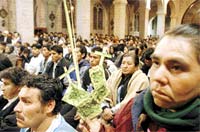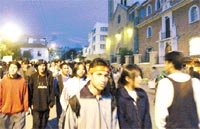Catholicism reached the New World to mix with the popular beliefs and customs of the people indigenous to America. The different way this faith is experienced in the traditional sectors of Obrajes (La Paz – Bolivia) has its roots in the native Andean culture.
Things that are considered unthinkable for the strict Catholic are common and customary in this cultural framework. The images of saints, virgins and even the crucified Christ take on a family feeling, and it is possible to speak with Christ as if one were speaking to a member of his/her own family: Loving, reproaching, correcting and pleading, praying, celebrating and sharing everything (including the images), a single reality and the same deep experience of faith.
 One very common custom among the devout is the presterío. Presteríos are groups of believers, whether relatives, acquaintances, friends or devotees of the same saint who agree to worship the image. They take turns having the image in their homes and taking care of it, once a year ordering a mass for the image and organizing a festival for the members of the Presterío. There are two ways in which one can be responsible for the image of a saint: volunteering to care for it or accepting the request from a friend. There are also two types of presteríos: the Major Presterío and the Minor Presterío.
One very common custom among the devout is the presterío. Presteríos are groups of believers, whether relatives, acquaintances, friends or devotees of the same saint who agree to worship the image. They take turns having the image in their homes and taking care of it, once a year ordering a mass for the image and organizing a festival for the members of the Presterío. There are two ways in which one can be responsible for the image of a saint: volunteering to care for it or accepting the request from a friend. There are also two types of presteríos: the Major Presterío and the Minor Presterío.
The images are not just companions or protectors for the home for these devotees. A devotee of the image of the Exalted Lord of Obrajes explains, for example, “I have volunteered [to care for the image] because I am a devotee of the Exalted Lord of Obrajes. This Lord that we have on the crucifix at the Obrajes Church is almost a brother to me. He is like a friend. Whenever I have asked for something, he has liberated me from misfortune.”
The processions during Lent that are organized by the minor presterío are a parade or a pilgrimage by youth and children of all ages. They leave Thursday night near midnight and walk, run, or jog to the Church of the Exaltation from different spots, chapels or churches in the city of La Paz or El Alto, arriving at the small Church of the Exaltation in Obrajes around 3 a.m. each Friday during Lent. They have been doing this for more than a hundred and fifty years.
These processions precede Holy Friday, the day they arrive an hour later and are made up not only of young people, but of entire families. These families spend almost the entire holiday on Holy Friday activities. The plaza has the feeling of a fair and a party that is a lot of fun for the children. Whole families attend the masses that are celebrated every hour starting at 6 a.m. until 11 a.m. The church is a place of meditation and solemnity where many people go to confession and approach the images of Jesus of Nazareth and the Virgin Dolorosa.
The major presteríos are the ones that organize the Holy Week festival right after the processions of Lent. At this festival, the devotee and his companions pick up the image of the Christ of the Sepulcher from the house of the current devotee where it has been all year. Then all the images are prepared for the Andas (wooden platforms used to carry the “Saints” in the procession) which have been organized, planned and built beginning in December of the prior year.
On Holy Friday the Andas are taken to the church where they are decorated for the procession. Around 5 p.m. the images of the Virgin Dolorosa, Jesus of Nazareth, the Lord of the Sepulcher and the Virgin Mary are placed on their own andas. At 18:30 the andas leave the church carried by believers and devotees.

The procession begins with the Anda of Jesus of Nazareth followed by the devotees (all the members of the minor presteríos) from Alto Obrajes, followed by the Anda of the Virgin Dolorosa. The second part begins with the Anda of the Lord of the Sepulcher followed by the devotees (all members of the Major Presteríos) from Bajo Obrajes, local authorities and the army followed by the Anda of the Virgin.
The two-hour procession is carried out along 13 blocks while the andas are carried by 60 believers at all times. They take turns with each other to voluntarily help carry the images. The procession ends when the Andas return to the church and “lay down” to “sleep” during the night.
A large part of the religious tradition in the country is a result of a unique understanding of the symbols and images brought by the conquistadors that were accepted and transformed over time into typical expressions of faith as much as of culture, family and community. This is one of those marvelous representations the Bolivian people maintain with pride.


